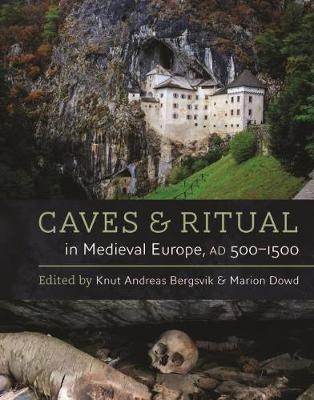
Caves and Ritual in Medieval Europe, AD 500–1500
Oxbow Books (Verlag)
978-1-78570-832-9 (ISBN)
- Titel ist leider vergriffen;
keine Neuauflage - Artikel merken
Caves and rockshelters in Europe have traditionally been associated with prehistory, and in some regions cave archaeology has become synonymous with the Palaeolithic. However, there is abundant evidence that caves and rockshelters were important foci for activities in historic times. During the medieval period (here taken as AD 500–1500) caves were used for short-term shelter, habitation, specialised craft activities, storage, as hideaways and for tending animals. Caves were also used for religious purposes. Caves and ritual in medieval Europe, AD 500–1500 focuses on this neglected field of research – the ritual and religious use of caves. It draws together interdisciplinary studies by leading specialists from across Europe: from Iberia to Crimea, and from Malta to northern Norway. The different religions and rituals in this vast area are unified by the use of caves and rockshelters, indicating that the beliefs in these natural places – and in the power of the underworld – were deeply embedded in many different religious practices. Christianity was widespread and firmly established in most of Europe at this time, and many of the contributions deal with different types of Christian practices, such as the use of rock-cut churches, unmodified caves for spiritual retreat, caves reputedly visited by saints, and caves as places for burials. But parallel to this, some caves were associated with localised popular religious practices, which sometimes had pre-Christian origins. Muslims in Iberia used caves for spiritual retreat, and outside the Christian domain in northern Europe, caves and rockshelters were places for carving symbols among Pictish groups, places for human burial, for bear burials amongst the Sámi, and places for crafting and votive deposition for Norse populations.
Knut Andreas Bergsvik is Professor of Archaeology in the University Museum at the University of Bergen, Norway. His main research interests are the human use of caves and rockshelters in Norway and social and economic change among hunter-fisher populations in Scandinavia. He has conducted a large number of archaeological excavations in western Norway. He is author of Ethnic Boundaries in Neolithic Norway (2006) and, together with Robin Skeates, he co-edited Caves in Context. The Cultural Significance of Caves and Rockshelters in Europe (2012). Marion Dowd is Lecturer in Prehistoric Archaeology at the Institute of Technology Sligo, Ireland. For two decades her research has focused on the human use of caves in Ireland, and specifically the role of caves in prehistoric ritual and religion. She has directed numerous archaeological excavations in Irish caves, and has lectured and published widely on the subject. Her first book, The Archaeology of Caves in Ireland (Oxbow, 2015), won the Tratman Award 2015 and the Current Archaeology Book of the Year 2016.
List of contributors
Preface
Chapter 1: Caves in medieval Europe: religious and secular use
Knut Andreas Bergsvik and Marion Dowd
NORTHWESTERN EUROPE
Chapter 2: Entering other realms: Sámi burials in natural rock cavities and caves
in northern Fenno-Scandinavia between 900 BC and AD 1700
Asgeir Svestad
Chapter 3: The use and perception of caves and rockshelters in late Iron Age and medieval Western Norway c. AD 550-1550
Knut Andreas Bergsvik
Chapter 4: A holy cave and womb: the sanctuary on the island of Selja and the birth of the first Norwegian saints
Alf Tore Hommedal
Chapter 5: Signs from the Pictish underground: early medieval cave ritual at the Sculptor’s Cave, northeast Scotland (c. AD 400-900)
Lindsey Büster and Ian Armit
Chapter 6: Marking caves in Scotland and Iceland: characterising an early medieval phenomenon
Kristján Ahronson
Chapter 7: Saintly associations with caves in early medieval Ireland (AD 400-1169)
Marion Dowd
IBERIA AND THE MEDITTERANEAN
Chapter 8: Hidden in the depths, far from people. Funerary activities in the Lower Gallery of La Garma and the use of natural caves as burial places in early medieval Cantabria, northern Spain
Pablo Arias, Roberto Ontañón, Enrique Gutiérrez Cuenca, José Ángel Hierro Gárate, Francisco Etxeberria, Lourdes Herrasti and Paloma Uzquiano
Chapter 9: Christian and Muslim patterns of secular and religious cave use in the Iberian Peninsula in Late Antiquity and the early middle Ages (fifth/sixth to eleventh/twelfth centuries AD)
Manel Feijoó
Chapter 10: The occupation and use of natural caves in the Ligurian-Piedmontese region between Late Antiquity and the early Middle Ages (fifth to late seventh century)
Paolo de Vingo
Chapter 11: The culture of rock-cut cemeteries and artificial ritual caves in Roman and Byzantine Malta
Mario Buhagiar
Chapter 12: Investigating cave dwelling in medieval Malta (AD 800-1530)
Keith Buhagiar
CENTRAL AND EASTERN EUROPE
Chapter 13: The use of caves for religious purposes in early medieval Germany (AD 500-1200)
Mechthild Schulze-Dörrlamm
Chapter 14: Knights in the dark: on the function of Polish caves in the Middle Ages
Michał Wojenka
Chapter 15: Medieval cave sites in the Czech Republic
Vladimír Peša
Chapter 16: Bull Rock Cave (Býčí skála), Czech Republic, and its environs in the Middle Ages
Martin Golec
Chapter 17: The form and fabric of Late Antique and medieval cave use in Slovenia
Agni Prijatelj
Chapter 18: The triconchial medieval cave churches of Eski-Kermen (Crimea): recent results of investigations
Nicolas V. Dneprovsky
| Erscheinungsdatum | 17.03.2018 |
|---|---|
| Zusatzinfo | b/w and colour |
| Verlagsort | Oxford |
| Sprache | englisch |
| Maße | 220 x 280 mm |
| Themenwelt | Geisteswissenschaften ► Archäologie |
| Geschichte ► Allgemeine Geschichte ► Mittelalter | |
| ISBN-10 | 1-78570-832-5 / 1785708325 |
| ISBN-13 | 978-1-78570-832-9 / 9781785708329 |
| Zustand | Neuware |
| Informationen gemäß Produktsicherheitsverordnung (GPSR) | |
| Haben Sie eine Frage zum Produkt? |
aus dem Bereich


